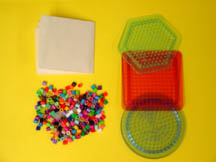BACKGROUND:
Both an artist and a scientist
have to think about their goal when they start a project. An artist has a vision of the end
product. A scientist also needs a goal for a research project.
Although the product of both an artist and a scientist are different, the
thought processes are very similar. The great artists of the world
made sketch after sketch before they actually produced their art.
Many students are not aware that even people with talent have to work to
make that talent a reality. No matter how talented a person is, developing
a masterpiece takes thought and conviction.
A scientist also has to continue to work on a
breakthrough. It takes time and patience for most discoveries to
happen.
Design is a word used to mean
composition, style or decoration. Composition is the framework of
relationship in a thing, considered analytically in isolation from the
parts and from the whole. Both artist and scientist have to consider both
design and composition if their project can fit into an overall scheme.
PROCEDURE:
- In this
lab, students will design art before they create it. On the lab sheet
they will have to think about how many colors they want, how many pieces
they will require, and generally what the design will look like.
As students progress from the design created on paper to the actual perler
beads, they may decide it is not what they wanted. In experiments,
as in design, it is acceptable to change the course of the project if the
original design was flawed.
-
 You can give a limit on the number of Perler Beads
you provide the students. It might consist of 20 red, 20 blue, 20
yellow, and 20 green. First you have the student design what the pattern
may look like or they can experiment with the beads on the
templates. In the kit there are 3 templates, a hexagon, square, and
circle. You may want students to see if the same number of beads can
create the same pattern on the different shapes. (Similar, but not
exactly.) You can give a limit on the number of Perler Beads
you provide the students. It might consist of 20 red, 20 blue, 20
yellow, and 20 green. First you have the student design what the pattern
may look like or they can experiment with the beads on the
templates. In the kit there are 3 templates, a hexagon, square, and
circle. You may want students to see if the same number of beads can
create the same pattern on the different shapes. (Similar, but not
exactly.)
- Perler beads are placed
one by one on a pegboard. When the design is complete, heat-seal
paper is placed over the design and it is ironed by an adult helper.
The beads fuse together quickly on what will become the backside of the
design. When it has cooled completely, the design is removed from
the pegboard. The pegboard is reusable, and the iron paper can be
used many times before it must be discarded. If you want to save
the perler beads, do not fuse the beads. It depends on budget if
you want to use this as a consumable or not. Use the design and idea
book for students to get ideas. Stress that great ideas and designs
usually built up from a previous knowledge. Looking for ideas is
not cheating.
- You may want to give the design phase as a homework assignment. Creativity
also needs time . Science and art are related.
|